Global Insights on OAE: Keynote Presentations
Dive into a curated collection of slides and insights from OAE-related presentations delivered at international conferences.
72nd American Society of Tropical Medicine and Hygiene (ASTMH) Annual Conference (October 18-22, 2023, Chicago, USA)
| Effect of onchocerciasis elimination interventions on the incidence of onchocerciasis-associated epilepsy in endemic areas | Luis-Jorge Amaral (Global Health Institute, University of Antwerp, Belgium) | More information available soon |
Projecting Onchocerca volvulus infection trends and times to onchocerciasis elimination using the EPIONCHO-IBM transmission model in Togo | Luis-Jorge Amaral (Global Health Institute, University of Antwerp, Belgium) | More information available soon |
Second International workshop on Onchocerciasis-Associated Epilepsy (September 19-21 2023, Antwerp, Belgium)
The Second International Workshop on OAE official web page with the event's programme, recordings, presentations and pictures can be found here.
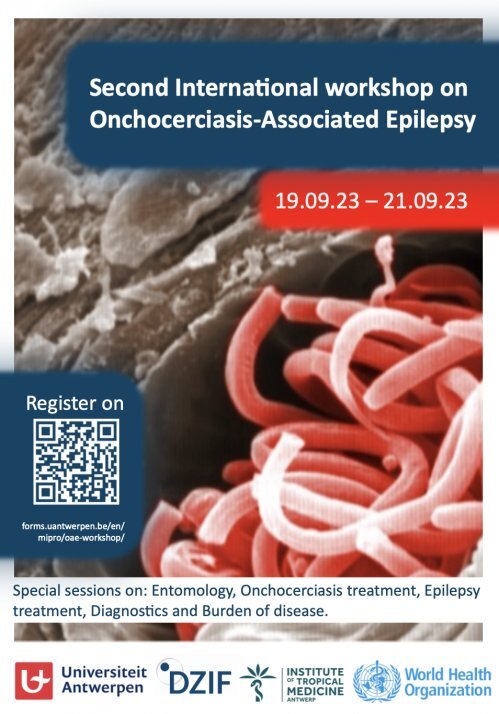
The Hydra Helminth Conferences (3-8 September, 2023, Hydra, Greece)
Studying the pathogenesis of Onchocerciasis-associated Epilepsy Novel Rhabdovirus, OVRV1, found in O. volvulus and Simulium | Amber Hadermann (Global Health Institute, University of Antwerp, Belgium) | |
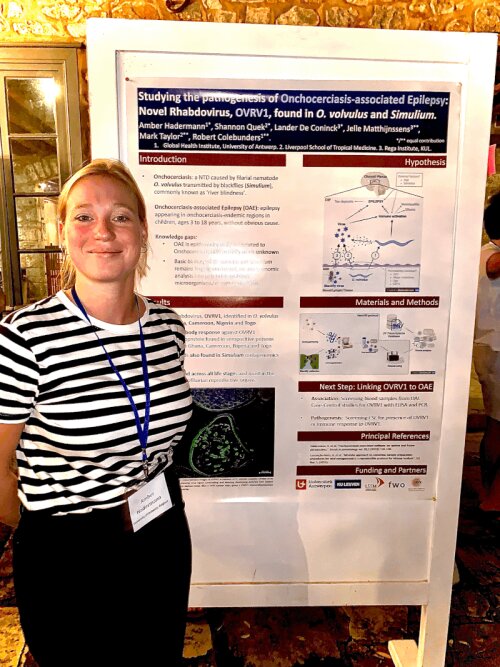
International Congress on Infectious Diseases 2022 (ISID, November 17–20, 2022, Kuala Lumpur, Malaysia)
Effect of bi-annual community-directed distribution with ivermectin (CDTI) and a community-based awareness programme on the incidence of onchocerciasis-associated epilepsy in Mahenge, Tanzania (oral presentation) | Luis-Jorge Amaral (Global Health Institute, University of Antwerp, Belgium) | |
Evaluation of a community-based prevention programme to decrease onchocerciasis-associated epilepsy in onchocerciasis endemic villages in South Sudan (oral presentation) | Luis-Jorge Amaral (Global Health Institute, University of Antwerp, Belgium) Stephen Jada (Amref Health Africa, Juba, South Sudan) |
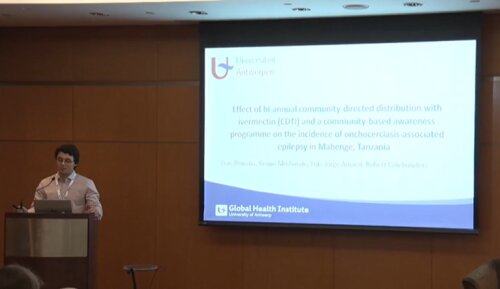
71st American Society of Tropical Medicine and Hygiene (ASTMH) Annual Conference (October 30 to November 3, 2022, Seattle, USA)
Effect of bi-annual community-directed distribution with ivermectin and a community-based "Slash and Clear" vector control method on the incidence of onchocerciasis-associated epilepsy in Maridi, in South Sudan: a three-year prospective study (oral presentation) | Luis-Jorge Amaral (Global Health Institute, University of Antwerp, Belgium) |
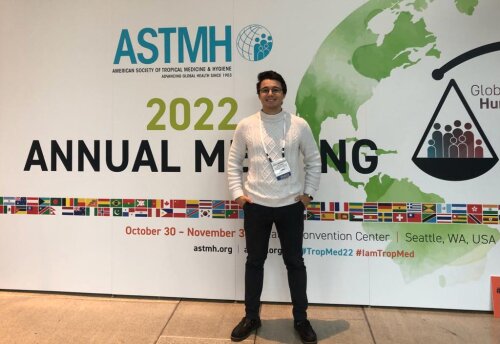
11th European Congress on Tropical Medicine and International Health (ECTMIH 2019)
The 11th edition of ECTMIH took place from 16 until 20 September 2019 in Liverpool (UK). On Thursday 19 September (10.00-12.30 am) prof. Bob Colebunders and prof. Maria-Gloria Basañez chaired an organised session entitled 'Morbidity Management and Disability prevention for onchocerciasis'.
Objectives: Although many years of community directed distribution of ivermectin, there is still high Onchocerca volvulus transmission in certain African regions. Moreover, in those regions there is a high prevalence of onchocerciasis-associated epilepsy (OAE). Current onchocerciasis elimination programs do not include identification and management of OAE in their strategies. In contrast, the Global Programme to Eliminate Lymphatic Filariasis has adopted a two-pronged approach which, in addition to deploying mass drug administration, has developed a strategy for morbidity management and disability prevention. In this session we intend to discuss the possibility to establish a similar strategy for onchocerciasis.
Speakers
- JN Siewe Fodjo, Global Health Institute, University of Antwerp, Belgium
Onchocerciasis- associated epilepsy: the epidemiological evidence 15 min
- A Hotterbeekx Global Health Institute, University of Antwerp, Belgium PhD
Onchocerciasis- associated epilepsy: the pathophysiological mechanism 15 min
- Charles D Mackenzie NTDSC, Task Force for Global Health, Atlanta, USA,
Caring for patients suffering from filarial infections: lessons learned from Lymphatic Filariasis programmes 15 min
- A Hopkins and Makoy Y Logora leading panel discussion on “Morbidity Management and Disability prevention for onchocerciasis” 45 min
4th African Epilepsy Congress (AEC 2019)
Purpose and objectives: Despite many years of community directed distribution of ivermectin, there is still high Onchocerca volvulus transmission in many African regions. Moreover, in those regions there is a high prevalence of onchocerciasis-associated epilepsy (OAE).
Current onchocerciasis elimination programs do not include identification and management of OAE in their strategies. The Global Programme to Eliminate Lymphatic Filariasis has adopted successfully a two-pronged approach with the deployment of mass drug administration and a strategy for morbidity management and disability prevention (MMDP).
In this session we intend to discuss the possibility to establish a similar strategy for onchocerciasis elimination programs.
Main conclusions
1. OAE evening session (21/08/2019)
- There is compelling epidemiological evidence that onchocerciasis causes epilepsy, including nodding syndrome and Nakalanga syndrome
- The pathophysiological mechanisms of OAE are still poorly understood, but investigations are ongoing (post-mortem studies, CSF assays, immunological investigations, etc.)
- Optimal onchocerciasis elimination programs are able to reduce the burden of OAE in affected communities
- Sustainable OAE interventions require collaboration between onchocerciasis and mental health programs
2. Rest of the AEC conference (22-24/08/2019)
- Neurocysticercosis and onchocerciasis were presented as two main reasons for the huge epilepsy burden in Africa. Public health measures targeting these diseases (better oro-fecal hygiene, rigorous pig rearing/cooking practices, vaccination, improved onchocerciasis elimination strategies) would curb the epilepsy incidence in the continent
- Wide treatment gap and limited human capacity still constitute barriers to epilepsy care in Africa. It was agreed that increasing access to the first line anti-epileptic drugs (phenobarbital, carbamazepine, valproate and phenytoin) and training primary healthcare workers in epilepsy management via decentralized clinics should be the way forward
- The role of telemedicine for epilepsy care (conference calls between local health workers and international experts, home video recording of seizures with mobile phones, communication via social media, etc.) offers promising perspectives
- Strong emphasis was laid on the psychosocial aspects of epilepsy care in order to overcome stigma and improve the quality of life of persons with epilepsy
- Local research, collaborations and interventions within the African context were encouraged
- National and international stakeholders were called to take the lead in epilepsy care, as echoed in the First Global Report on Epilepsy released by the WHO in June 2019
10th European Congress on Tropical Medicine and International Health (ECTMIH 2017, 16-20 October 2017, Antwerp)
| Epidemiology of onchocerciasis and epilepsy in Ituri province, Democratic Republic of the Congo | Evy Lenaerts (Global Health Institute, University of Antwerp, Belgium) | Download (pdf-377 kB) |
| High prevalence of epilepsy in two rural villages in Mahenge area, Tanzania: after 20 years of community directed treatment with ivermectin | Bruno Mmbando (National Institute for Medical Research, Tanzania) | Download (pdf-525 kB) |
1st International Workshop on Onchocerciasis-Associated Epilepsy (OAE 2017, 12-14 October 2017, Antwerp)
Scientific presentations
| Welcome and objectives of OAE 2017 | Bob Colebunders (Global Health Institute, University of Antwerp, Belgium) | Download (pdf-654 kB) |
| Update OAE research in Uganda | Richard Idro (Makerere University, Uganda) | Download (pdf-1,7 MB) |
| Update OAE research in the Democratic Republic of the Congo | Michel Mandro (Ministry of Health, DRC) | Download (pdf-1,0 MB) |
| Update OAE research in Tanzania | Bruno Mmbando (National Institute for Medical Research, Tanzania) | Download (pdf-728 kB) |
| Update OAE research in Cameroon | Michel Boussinesq (IRD, France) & Alfred Njamnshi (University of Yaoundé, Cameroon) | Download (pdf- 666 kB) |
| OAE anthropological research | Julia Irani & Maya Ronse (Institute of Tropical Medicine, Belgium) | Download (pdf-672 kB) |
| Update entomological investigations | Adam Hendy (Institute of Tropical Medicine, Belgium) | Download (pdf-1,2 MB) |
Oral poster presentations
| Prevalence and annual incidence of Nodding Syndrome and other forms of epilepsy in onchocerciasis endemic areas of northern Uganda | Martin Mbonye (Makerere University, Uganda) | Download (pdf - 700 kB) |
| Recent findings on ochocerciasis-associated epilepsy in Bilomo (Cameroon) | Joseph Nelson Siewe (University of Antwerp, Belgium) | Download (pdf - 642 kB) |
| Improving the care and the treatment outcomes of children and adolescents with Nodding Syndrome and other Epilepsies through training, support supervision, research, and collaborations in Uganda | Catherine Abbo (Makerere University, Uganda) | Download (pdf - 741 kB) |
| Cognitive impairment, sleep and mood disorders in PWE Living in an Onchocerciasis Endemic region in Cameroon | Leonard Nfor Njamnshi (University of Yaoundé1, Cameroon) | Download (pdf - 497 kB) |
| Cumulative doses of Ivermectin and seizure control in Ugandan children and adolescents with Nodding Syndrome on anti-epileptic drug therapy | Albert Ningwa (Makerere University, Uganda) | Download (pdf - 539 kB) |
| Asymptomatic malaria and seizure control in children with an epilepsy disorder; the nodding syndrome | Rodney Ogwang (Makerere University, Uganda) | Download (pdf - 578 kB) |
Working group presentations
| Working group 1: The burden of OAE and costs | Nathalie Vinkeles-Melchers & Sarah Mollenkopf | Download (pdf-1,1 MB)) |
| Working group 2: How to improve surveillance for epilepsy in onchocerciasis endemic regions and to improve treatment/care for persons with OAE? | Richard Idro & Pierre-Marie Preux | Download (pdf-228 kB) |
| Working Group 3: How to strengthen weak onchocerciasis elimination programs and prevent OAE? Need to investigate ivermectine resistance? | Maria-Gloria Basàñez & Adrian Hopkins | Download (pdf-354 kB) |
| Working Group 4: How to deal with misconceptions, stigma, discrimination and gender violence associated with OAE? | Sarah O'Neill & Alfred Njamnshi | Download (pdf-267 kB) |
| Working Group 5: How to identify risk factors for and the pathophysiological mechanism causing OAE? | An Hotterbeeckx & Tom Nutman | Download (pdf-516 kB) |
| Working Group 6: How to create an OAE partnership and increase funding? A humanitarian impact bond proposal for OAE? | Patrick Suykerbuyk | Download (pdf-1,2 MB) |
65th American Society of Tropical Medicine and Hygiene (ASTMH) Annual Conference (November 14 2016, Altanta, USA)
Scientific presentation
High prevalence of epilepsy in onchocerciasis endemic regions in the Democratic Republic of the Congo (DRC) | Bob Colebunders (Global Health Institute, University of Antwerp, Belgium) | Download (pdf-654 kB) |
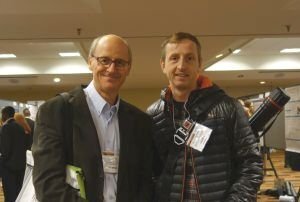
Dr Robert Colebunders (left) and Sebastien Pion (right) at ASTMH 2016